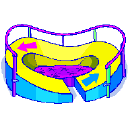

As you might suspect, the big wave usually swallows the smaller wave!
Physicists would say that the energy of the big wave was higher than the barrier of the smaller; thus the big wave has the force to cross over and swallow the smaller. However, the smaller wave's energy is no match for the large wave's barrier! So not much of it can cross the larger wave's path when the two meet!
Now, imagine a ball rolling down a ramp then up another ramp. To get up the second ramp the ball needs to build enough momentum on the first ramp.

The momentum gained on the first ramp is something like the infectivity of the HIV.
The infectivity is determined (1), by the person's overall viral load multiplied by how much of that viral load actually gets into the fluid transmitting the virus: (2), by the length of contact between the infected person and the person exposed; and(3), by the infectivity of the particular variety of the virus.
Viral Load: things that affect the person's viral load include the stage of infection, the person's genetic resistance, and the person's overall health.
The height of the second ramp acts like a barrier to the force built up on the first! It is something like the resistance of the person exposed to the virus.
The resistance is determined by any barriers the person uses, the intactness of the person's mucosal areas, the way the person is exposed, the person's overall health, and his/her genetic resistance!
Type of Exposure: remember, some fluids and tissues are infected more easily than are others, for example blood is infected easily by HIV, but saliva is not as easily infected; skin provides a real barrier--provided that the skin is not broken.
The higher the first ramp, the more momentum the ball builds. The higher the second ramp, the harder it is for the ball to get up.
The virus acts like the rolling ball: the more copies of the virus, and also the more virulent the virus, the more energy HIV has for crossing a barrier!
Number of Copies of the Virus: these are determined as we said by things like the viral load of the infected person, the type of fluid transmitting the virus; also determined by the length of contact.
Virulence: some subvarieties of HIV are considered to be more virulent than others!
The barrier of your skin and intact mucosa, any artificial barriers, your own flora and fauna (your flora and fauna are the microbes that live in harmony with your body, that help you digest your food for example!), and your body's immune response act like a barrier to the energy of the virus. If your skin and mucosa are healthy, if your flora and fauna are in balance, if you are well-rested and well-nourished, then the resulting barrier or resistance to infection is high!
Some artificial barriers, like the latex gloves doctors use, can help make the barrier higher; other artificial things, such as some microbiocides, may actually upset your own response.
Looking back at the waves again, not all the water in the smaller wave is swallowed by the bigger wave. Some drops from the smaller wave cross the bigger wave's barrier, even though it is too high!

Yes, no barrier is perfect. There is always a certain probability that something can cross a barrier, in both physics and biology. So some water from the wave gets across. In atomic physics, some particles may cross barriers that they do not have the energy to cross! In biology, even with great health and great resistance and other barriers, there is a risk of getting sick! But the risk of getting infected by HIV when handling fluids can be at least reduced!
If your skin is healthy and without cuts or lesions, hugging and dry-kissing are safe.
If your teeth and gums are healthy, wet kissing is fairly safe, since saliva poses little risk. For deep kissing, the degree of risk is less certain, however.
If your mucosa in healthy (the lining in your mouth, nose, esophogus, etc.)--that is, if it's not infected and its own beneficial flora and fauna (the good bacteria and yeast in your system) are in balance, and if you eat plenty of fiber, it can provide some barrier to microbes--depending on the microbe of course. But if your teeth are not healthy, it's unlikely that your mucosa is either as tooth and gum infections will cause it to become infected and out of balance as well.
Latex gloves can help protect your hands when you handle fluids or blood of any kind.
How infective are fluids outside of the body? This depends on how long the virus can survive in fluids or in dried fluids outside of the body, which in turn depends on the t-cell and to some degree on the macrophage concentration in the fluids, which goes down over time! HIV needs these cells--to live in and reproduce in!) Once blood is dried, it is fairly safe; however, since blood is rich in t-cells, undried blood containing HIV may remain infective outside the body for some time!
How do particles cross a barrier? like latex What holds a barrier together? It depends some on the kind of barrier. Latex is made of molecules and molecules are held together by electrical bonds. The virus has to be small enough or have enough energy to penetrate 'holes' in this barrier. The bonds are what gives this barrier its energy. The barrier to viruses in your skin is partly the skin itself which is made of cells, and partly the antibodies in it which can attach to a virus.